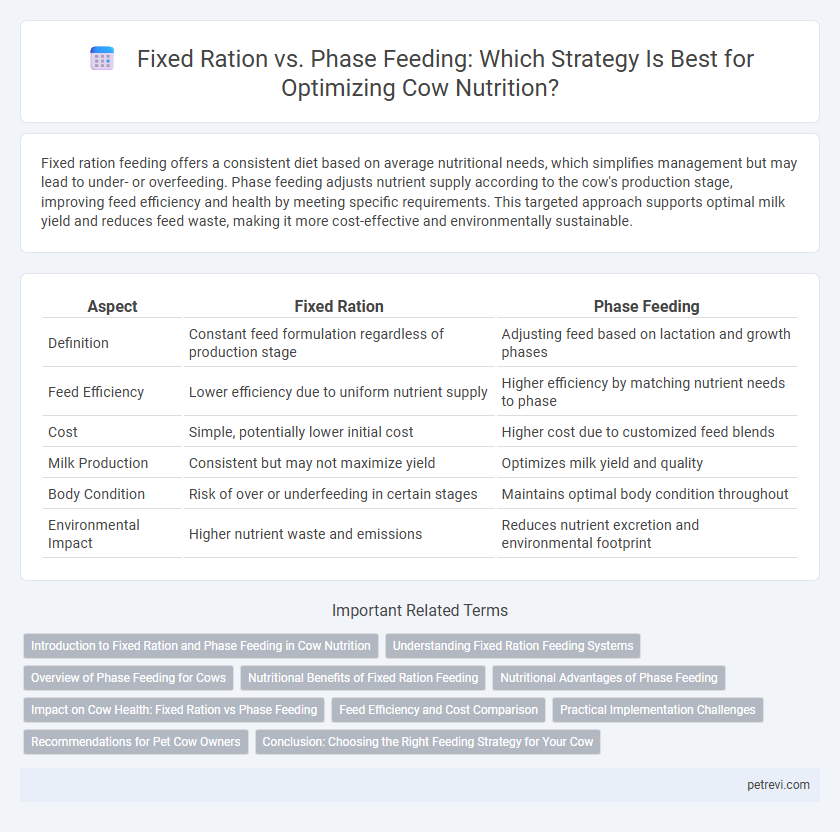Fixed ration feeding offers a consistent diet based on average nutritional needs, which simplifies management but may lead to under- or overfeeding. Phase feeding adjusts nutrient supply according to the cow's production stage, improving feed efficiency and health by meeting specific requirements. This targeted approach supports optimal milk yield and reduces feed waste, making it more cost-effective and environmentally sustainable.
Table of Comparison
| Aspect | Fixed Ration | Phase Feeding |
|---|---|---|
| Definition | Constant feed formulation regardless of production stage | Adjusting feed based on lactation and growth phases |
| Feed Efficiency | Lower efficiency due to uniform nutrient supply | Higher efficiency by matching nutrient needs to phase |
| Cost | Simple, potentially lower initial cost | Higher cost due to customized feed blends |
| Milk Production | Consistent but may not maximize yield | Optimizes milk yield and quality |
| Body Condition | Risk of over or underfeeding in certain stages | Maintains optimal body condition throughout |
| Environmental Impact | Higher nutrient waste and emissions | Reduces nutrient excretion and environmental footprint |
Introduction to Fixed Ration and Phase Feeding in Cow Nutrition
Fixed ration feeding in cow nutrition involves providing a consistent diet formulated to meet the average nutrient requirements throughout the production cycle, simplifying management but potentially leading to nutrient imbalances. Phase feeding adjusts the cow's diet in distinct stages aligned with physiological changes, optimizing nutrient intake for growth, lactation, and reproduction, thereby enhancing feed efficiency and reducing waste. Strategic application of phase feeding supports improved milk yield, reproductive performance, and overall health by tailoring nutrient supply to specific production phases.
Understanding Fixed Ration Feeding Systems
Fixed ration feeding systems for cows involve providing a consistent, unchanging diet throughout specific production phases, ensuring nutrient intake remains stable but may not match the varying nutritional needs during lactation or growth. This method simplifies feeding management and reduces monitoring requirements but risks underfeeding or overfeeding certain nutrients as cows' demands fluctuate. Optimal cow nutrition often requires balancing fixed rations with adjustments based on production stage, health status, and milk yield for enhanced feed efficiency and dairy performance.
Overview of Phase Feeding for Cows
Phase feeding for cows involves adjusting the nutrient supply according to specific production stages such as lactation, growth, or dry periods, optimizing feed efficiency and reducing nutrient wastage. This targeted approach contrasts with fixed rations by providing precise energy, protein, and mineral levels tailored to the varying physiological needs of cows during different phases. Implementing phase feeding enhances milk yield, reproductive performance, and overall cow health while minimizing environmental impact through lower nutrient excretion.
Nutritional Benefits of Fixed Ration Feeding
Fixed ration feeding provides consistent nutrient intake, supporting stable rumen function and optimizing milk production in dairy cows. This method simplifies dietary management by delivering balanced energy, protein, vitamins, and minerals in each meal, reducing the risk of nutritional deficiencies. Enhanced feed efficiency and improved body condition are common benefits observed with fixed ration feeding in lactating and dry cows.
Nutritional Advantages of Phase Feeding
Phase feeding provides precise nutrient delivery tailored to each stage of a cow's production cycle, enhancing feed efficiency and reducing nutrient waste. It optimizes protein and energy intake, supporting better milk yield and improved body condition during lactation. This approach also minimizes environmental impact by lowering nitrogen and phosphorus excretion compared to fixed ration feeding.
Impact on Cow Health: Fixed Ration vs Phase Feeding
Fixed ration feeding provides consistent nutrient delivery but may lead to imbalances affecting cow digestion and immune function. Phase feeding adjusts nutrient supply according to the cow's lactation stage, enhancing metabolic health and reducing risks of disorders like ketosis and acidosis. Research shows phase feeding improves overall cow health by optimizing nutrient intake and supporting robust immune responses.
Feed Efficiency and Cost Comparison
Fixed ration feeding in cows provides a consistent nutrient supply but often results in lower feed efficiency and higher costs due to overfeeding or underfeeding specific nutrients. Phase feeding adjusts nutrient supply according to the cow's production stage, enhancing feed efficiency by tailoring protein and energy intake, which reduces feed waste and overall feed costs. Studies indicate phase feeding can improve feed conversion ratios by up to 15%, translating into significant savings in total feed expenses across lactation cycles.
Practical Implementation Challenges
Fixed ration feeding in cows often faces challenges such as inaccurate matching of nutrient supply to changing physiological needs, leading to inefficiencies in milk production and feed utilization. Phase feeding requires detailed monitoring and adjustments based on lactation stage, which can be resource-intensive and demands precise record-keeping and skilled labor. Practical implementation difficulties include variability in feed composition, lack of real-time data, and the need for specialized equipment to optimize the nutrient delivery in phase feeding systems.
Recommendations for Pet Cow Owners
Pet cow owners should prefer phase feeding over fixed rations to optimize nutrient intake according to the cow's growth, lactation, and maintenance stages. Phase feeding adjusts protein, energy, and mineral levels to enhance health and productivity while reducing feed waste. Implementing phase feeding can improve digestion efficiency, minimize nutrient imbalances, and lower overall feeding costs for pet cows.
Conclusion: Choosing the Right Feeding Strategy for Your Cow
Selecting the appropriate feeding strategy for cows depends on balancing nutritional efficiency and cost-effectiveness. Fixed ration systems offer simplicity and consistency, while phase feeding adjusts nutrient supply to different lactation or growth stages, optimizing performance and reducing feed waste. Implementing phase feeding typically enhances milk production, improves health, and lowers feed costs, making it the preferred choice for dairy operations focused on maximizing productivity.
Fixed ration vs Phase feeding for Cow nutrition Infographic

 petrevi.com
petrevi.com